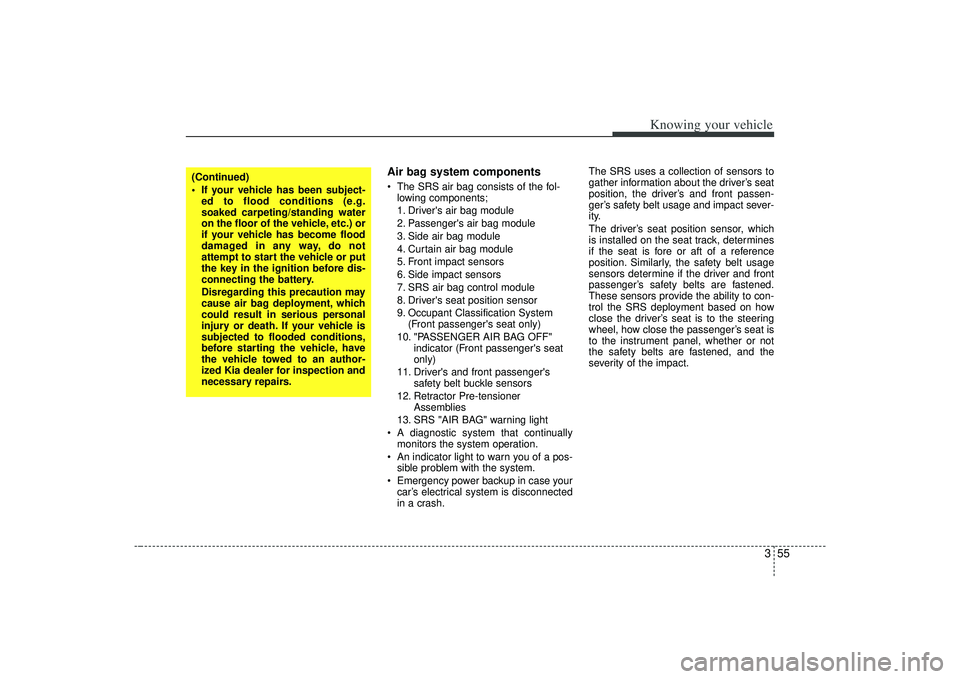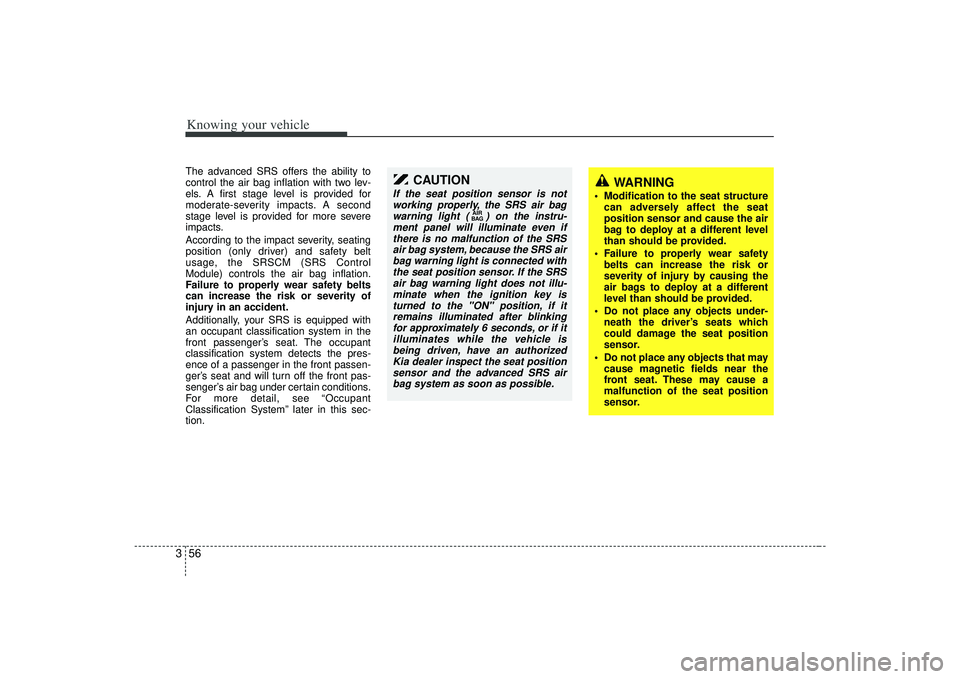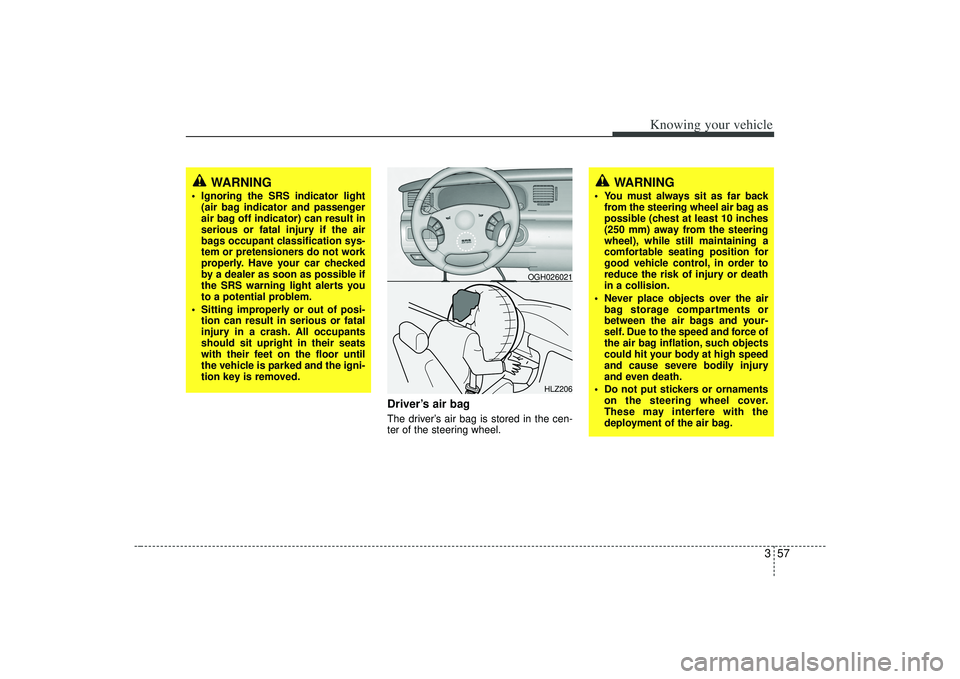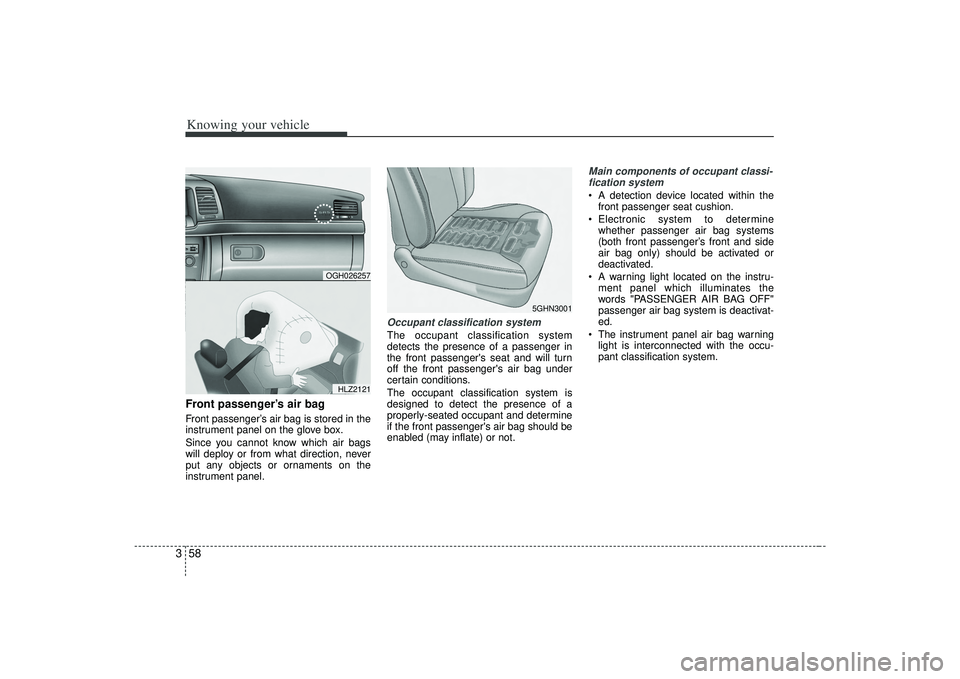KIA AMANTI 2009 Repair Manual
Manufacturer: KIA, Model Year: 2009, Model line: AMANTI, Model: KIA AMANTI 2009Pages: 321, PDF Size: 23.77 MB
Page 61 of 321

349
Knowing your vehicle
Child seat lower anchorsSome child seat manufacturers make
child restraint seats that are labeled as
LATCH or LATCH compatible. LATCH
stands for “Lower Anchors and Tethers
for Children”. These seats include two
rigid or webbing mounted attachments
that connect to two lower anchors and a
tether anchors at specific seating posi-
tions in your vehicle. This type of child
restraint seat eliminates the need to use
seat belts to attach the child seat in the
rear seats.
WARNING
- Tether strap
If the tether strap is secured incor-
rectly, the child restraint seat may
not be restrained properly in the
event of a collision. Do not mount
more than one child restraint seat
to a tether anchorage, since the
anchorage can then fail in a colli-
sion.
2GHN2025A
WARNING
- Child restraint
Check that the child restraint sys-
tem is secure by pushing and
pulling it in different directions.
Incorrectly fitted child restraints
may swing, twist, tip or come away
causing death or injury.
WARNING
- Child restraintanchorage
Child restraint anchorages are
designed to withstand only those
loads imposed by correctly fitted
child restraints. Under no circum-
stances are they to be used for
adult seat belts or harnesses or
for attaching other items or
equipment to the vehicle.
The tether strap may not work properly if attached somewhere
other than the correct tether
anchor.
Page 62 of 321

Knowing your vehicle50
3There is a child restraint symbol located
on the lower portion of each side of the
rear seatbacks. These symbols indicate
the position of the lower anchors for child
restraints so equipped. LATCH anchors have been provided in
your vehicle. The LATCH anchors are
located in the left and right outboard rear
seating positions. Their locations are
shown in the illustration. There is no
LATCH anchor provided for the center
rear seating position.
The LATCH anchors are located between
the seatback and the seat cushion of the
rear seat left and right outboard seating
positions.Follow the child seat manufacturer’s
instructions to properly install child
restraint seats with LATCH or LATCH-
compatible attachments.
Once you have installed the LATCH child
restraint, assure that the seat is properly
attached to the LATCH and tether
anchors. Also, test the child restraint seat
before you place the child in it. Tilt the
seat from side to side. Also try to tug the
seat forward. Check to see if the anchors
hold the seat in place.
6GHA2127
2GHA2127/SBGQ03102
CAUTION
Do not allow the rear seat belt web-
bing to get scratched or pinched bythe child-seat latch and LATCH anchor during the installation.
ISOFIX AnchorISOFIX Anchor
Position Indicator
Page 63 of 321

351
Knowing your vehicle
WARNING
If the child restraint is not anchored
properly, the risk of a child being
seriously injured or killed in a colli-
sion greatly increases.
WARNING
When using the vehicle’s “LATCH”
system to install a child restraint
system in the rear seat, all unused
vehicle rear seat belt metal latch
plates or tabs must be latched
securely in their seat belt buckles
and the seat belt webbing must be
retracted behind the child restraint
to prevent the child from reaching
and taking hold of unretracted seat
belts. Unlatched metal latch plates
or tabs may allow the child to reach
the unretracted seat belts which
may result in strangulation and a
serious injury or death to the child
in the child restraint.
WARNING
Do not mount more than onechild restraint to a single tether or
to a child restraint lower anchor-
age point. The improper
increased load may cause the
anchorage points or tether
anchor to break, causing serious
injury or death.
Do not install a child restraint seat at the rear center seating
position using the vehicle’s
LATCH anchors. The LATCH
anchors are only provided for the
left and right outboard rear seat-
ing positions. Do not misuse the
LATCH anchors by attempting to
attach a child restraint seat in the
middle rear seating position to
the LATCH anchors.
In a crash, the child restraint seat
LATCH attachments may not be
strong enough to secure the child
restraint seat improperly in the
rear center seating position and
may break, causing serious injury
or death.
(Continued)
(Continued)
Attach the LATCH or LATCH-com-patible child restraint seat only to
the appropriate locations shown
in the illustration.
Always follow the installation and use instructions provided by the
manufacturer of the child restraint.
Page 64 of 321

Knowing your vehicle52
3AIR BAG - ADVANCED SUPPLEMENTAL RESTRAINT SYSTEM ➀Driver’s air bag
➁Front passenger’s
air bag
➃Curtain Air bag
➄Front impact
sensor
➆SRS control module\bSide impact sensor
OGH026020N/OGH026021/OGH026257/1GHA2126/1GHA2127/2GHA2125/OGH026024/2GHA\
2128/OGH026023/1LDN2167/5GHN3001
➂Side air bag\fOccupant classi-
fication system
➇Front seat position
sensor
Page 65 of 321

353
Knowing your vehicle
What your air bag system doesDriver’s air bag and front passenger’s air
bag are designed to supplement the pro-
tection offered by the safety belt in cer-
tain frontal collisions. Likewise, side air
bag and curtain air bags are designed to
supplement the protection offered by the
safety belt in side collisions. Safety belts
are designed to reduce the injury of the
driver or passengers in case of impact or
collision. No safety belt or air bag system
can completely eliminate injuries that
may be caused in collisions or impacts.
To help reduce impact on driver or pas-
sengers in any collision, safety belts
must be correctly worn.
What your air bag system does
not doThe air bag system is designed to sup-
plement the protection offered by the
safety belt system.IT IS NOT A SUB-
STITUTE FOR THE SAFETY BELT.
The importance of using
safety beltsThere are four very important reasons to
use safety belts even with an air bag
supplemental restraint system. They:
help keep you in the proper position (away from the air bag) when it inflates.
reduce the risk of harm in rollover, side impact (vehicles not equipped with
side and curtain air bags) or rear
impact collisions, because an air bag is
not designed to inflate in such situa-
tions and even a side curtain air bag is
designed to inflate only in certain side
impact collisions.
reduce the risk of harm in frontal or side collisions which are not severe
enough to actuate the air bag supple-
mental restraint system.
reduce the risk of being ejected from your vehicle.
Page 66 of 321

Knowing your vehicle54
3✽
✽
NOTICEYour vehicle’s Supplemental Restraint
System Control Module is equipped
with a recording device that may record
the use or status of the safety belt
restraint system by the driver and front
passenger in certain collisions.
WARNING
- Air bags &
safety belts
Even in vehicles with air bags,
you and your passengers must
always wear the safety belts pro-
vided in order to minimize the risk
and severity of injury in the event
of a collision or rollover.
Always wear your safety belt. It can help keep you away from the
air bags during heavy braking
just before a collision.
If occupants are not wearing safe- ty belts or correctly seated, they
cannot be protected, and thus
face serious injury or death.
(Continued)
(Continued)
Driver’s and front passenger’s airbags are designed to inflate only
in certain frontal collision, and
side and curtain air bags are
designed to inflate in certain side
impacts. Frontal air bags will gen-
erally not provide protection in
side impacts (vehicles not
equipped with side and curtain air
bags) or rear impacts, rollovers,
less severe frontal collisions.
They will not provide protection
from later impacts in a multi-
impact collision.
(Continued)
Page 67 of 321

355
Knowing your vehicle
Air bag system components The SRS air bag consists of the fol-lowing components;
1. Driver's air bag module
2. Passenger's air bag module
3. Side air bag module
4. Curtain air bag module
5. Front impact sensors
6. Side impact sensors
7. SRS air bag control module
8. Driver's seat position sensor
9. Occupant Classification System (Front passenger's seat only)
10. "PASSENGER AIR BAG OFF" indicator (Front passenger's seat
only)
11. Driver's and front passenger's safety belt buckle sensors
12. Retractor Pre-tensioner Assemblies
13. SRS "AIR BAG" warning light
A diagnostic system that continually monitors the system operation.
An indicator light to warn you of a pos- sible problem with the system.
Emergency power backup in case your car’s electrical system is disconnected
in a crash. The SRS uses a collection of sensors to
gather information about the driver’s seat
position, the driver’s and front passen-
ger’s safety belt usage and impact sever-
ity.
The driver’s seat position sensor, which
is installed on the seat track, determines
if the seat is fore or aft of a reference
position. Similarly, the safety belt usage
sensors determine if the driver and front
passenger’s safety belts are fastened.
These sensors provide the ability to con-
trol the SRS deployment based on how
close the driver’s seat is to the steering
wheel, how close the passenger’s seat is
to the instrument panel, whether or not
the safety belts are fastened, and the
severity of the impact.
(Continued)
If your vehicle has been subject-
ed to flood conditions (e.g.
soaked carpeting/standing water
on the floor of the vehicle, etc.) or
if your vehicle has become flood
damaged in any way, do not
attempt to start the vehicle or put
the key in the ignition before dis-
connecting the battery.
Disregarding this precaution may
cause air bag deployment, which
could result in serious personal
injury or death. If your vehicle is
subjected to flooded conditions,
before starting the vehicle, have
the vehicle towed to an author-
ized Kia dealer for inspection and
necessary repairs.
Page 68 of 321

Knowing your vehicle56
3The advanced SRS offers the ability to
control the air bag inflation with two lev-
els. A first stage level is provided for
moderate-severity impacts. A second
stage level is provided for more severe
impacts.
According to the impact severity, seating
position (only driver) and safety belt
usage, the SRSCM (SRS Control
Module) controls the air bag inflation.
Failure to properly wear safety belts
can increase the risk or severity of
injury in an accident.
Additionally, your SRS is equipped with
an occupant classification system in the
front passenger’s seat. The occupant
classification system detects the pres-
ence of a passenger in the front passen-
ger’s seat and will turn off the front pas-
senger’s air bag under certain conditions.
For more detail, see “Occupant
Classification System” later in this sec-
tion.
CAUTION
If the seat position sensor is not
working properly, the SRS air bag warning light ( ) on the instru-ment panel will illuminate even ifthere is no malfunction of the SRSair bag system, because the SRS airbag warning light is connected with the seat position sensor. If the SRSair bag warning light does not illu- minate when the ignition key isturned to the "ON" position, if it remains illuminated after blinkingfor approximately 6 seconds, or if it illuminates while the vehicle isbeing driven, have an authorizedKia dealer inspect the seat positionsensor and the advanced SRS air bag system as soon as possible.
AIR
BAG
WARNING
Modification to the seat structure
can adversely affect the seat
position sensor and cause the air
bag to deploy at a different level
than should be provided.
Failure to properly wear safety belts can increase the risk or
severity of injury by causing the
air bags to deploy at a different
level than should be provided.
Do not place any objects under- neath the driver’s seats which
could damage the seat position
sensor.
Do not place any objects that may cause magnetic fields near the
front seat. These may cause a
malfunction of the seat position
sensor.
Page 69 of 321

357
Knowing your vehicle
Driver’s air bagThe driver’s air bag is stored in the cen-
ter of the steering wheel.
HLZ206
OGH026021
WARNING
Ignoring the SRS indicator light(air bag indicator and passenger
air bag off indicator) can result in
serious or fatal injury if the air
bags occupant classification sys-
tem or pretensioners do not work
properly. Have your car checked
by a dealer as soon as possible if
the SRS warning light alerts you
to a potential problem.
Sitting improperly or out of posi- tion can result in serious or fatal
injury in a crash. All occupants
should sit upright in their seats
with their feet on the floor until
the vehicle is parked and the igni-
tion key is removed.
WARNING
You must always sit as far backfrom the steering wheel air bag as
possible (chest at least 10 inches
(250 mm) away from the steering
wheel), while still maintaining a
comfortable seating position for
good vehicle control, in order to
reduce the risk of injury or death
in a collision.
Never place objects over the air bag storage compartments or
between the air bags and your-
self. Due to the speed and force of
the air bag inflation, such objects
could hit your body at high speed
and cause severe bodily injury
and even death.
Do not put stickers or ornaments on the steering wheel cover.
These may interfere with the
deployment of the air bag.
Page 70 of 321

Knowing your vehicle58
3Front passenger’s air bagFront passenger’s air bag is stored in the
instrument panel on the glove box.
Since you cannot know which air bags
will deploy or from what direction, never
put any objects or ornaments on the
instrument panel.
Occupant classification systemThe occupant classification system
detects the presence of a passenger in
the front passenger's seat and will turn
off the front passenger's air bag under
certain conditions.
The occupant classification system is
designed to detect the presence of a
properly-seated occupant and determine
if the front passenger's air bag should be
enabled (may inflate) or not.
Main components of occupant classi-
fication system A detection device located within the front passenger seat cushion.
Electronic system to determine whether passenger air bag systems
(both front passenger’s front and side
air bag only) should be activated or
deactivated.
A warning light located on the instru- ment panel which illuminates the
words "PASSENGER AIR BAG OFF"
passenger air bag system is deactivat-
ed.
The instrument panel air bag warning light is interconnected with the occu-
pant classification system.
5GHN3001
OGH026257
HLZ2121